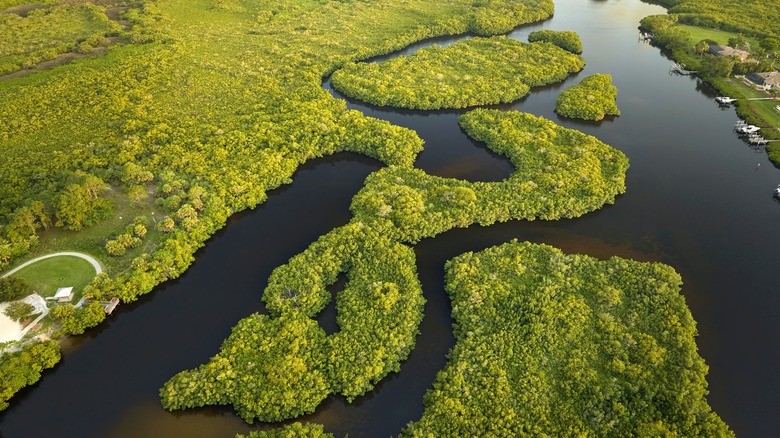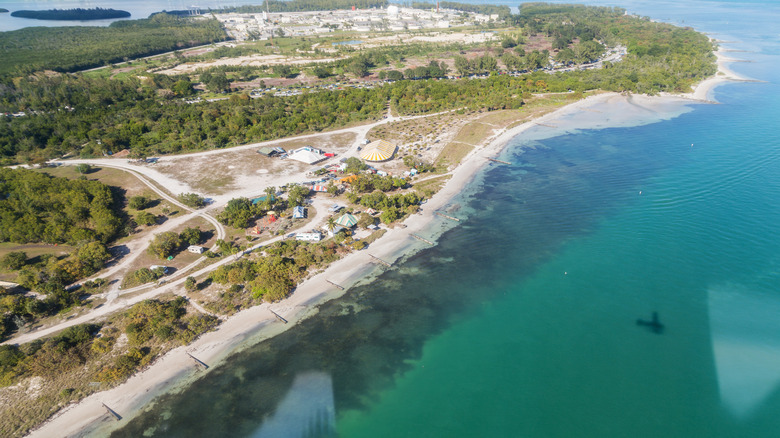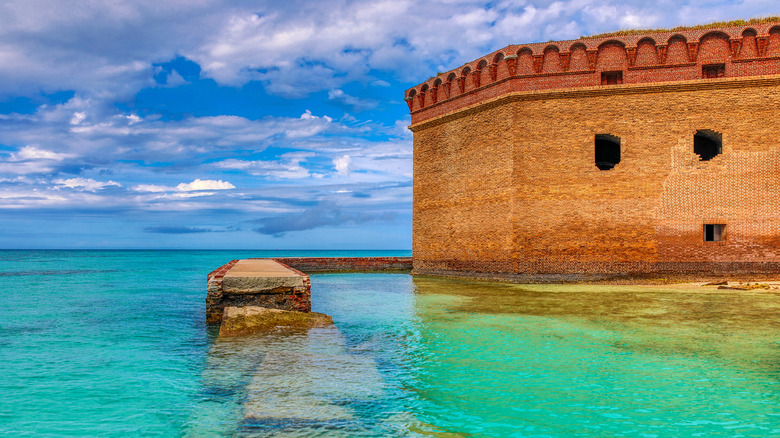The Best Road Trip Itinerary For Exploring Three Of Florida's National Parks
Road trip routes connecting multiple national parks in one itinerary might sound like something relatively easy to accomplish in the western United States. For example, those taking Utah's Mighty 5 road trip check off five national parks in one trip, and the breathtaking road from Denver to Yellowstone National Park can help you check off three more. Continuing the theme, Florida has three spectacular standalone national parks, and they can all be visited on one route.
In the southernmost part of the Sunshine State are the Everglades, Biscayne, and Dry Tortugas National Parks. Given that Everglades National Park covers more of mainland Florida than the others, the famous tropical wilderness is the best place to start. What makes this park special is its biodiversity, as the park is filled with alligators, migratory birds, manatees, and so much more. If you're not sure where to start in this massive park (the largest subtropical wilderness in the U.S., no less), head to one of its visitor centers. The Shark Valley, Guy Bradley at Flamingo, Gulf Coast, and Ernest F. Coe Visitor Centers can provide guided tours and show you where to camp, find hiking trails, and more. These buildings (except Flamingo) also coincide with the park's entrances. Try to spend more than just one day exploring this iconic yet shrinking ecosystem; you won't regret it.
Most of Biscayne National Park is in the ocean
While the entrances are at multiple sections of Everglades National Park, the closest one to Biscayne National Park is Ernest F. Coe, near the town of Florida City. From this town, head east for just over 10 miles to the Dante Fascell Visitor Center in order to start exploring Biscayne National Park. Not only is this building packed with educational information, it is located near a peaceful boardwalk jutting into the ocean. To make the most of a visit to Biscayne, venturing out onto the water is a must — after all, most of the park is water. Organize your boat, kayak, canoe, or snorkeling trips through the Biscayne National Park Institute near the visitor center. Snorkeling, in particular, is a must, as Biscayne is near the expansive Florida Reef, which stretches all along the Florida Keys to Dry Tortugas.
What makes the 136 mile trip from Biscayne to the land connection point for Dry Tortugas National Park so appealing is that you'll traverse the Florida Keys. This is an unforgettable Florida road trip in and of itself. Use Highway 1 to get from the mainland to Key Largo. Among the many possible pit stops here are John Pennekamp Coral Reef State Park for boat and snorkel tours or Dolphins Plus Bayside, where you can swim with dolphins in a natural ocean setting rather than an artificial pool.
Mix history with nature at Dry Tortugas National Park
As you continue the drive through the Florida Keys, take a vacation from your vacation at Sombrero Beach in Marathon. Most of the beach is freed up for white sand relaxation year-round, but be aware of endangered sea turtle nests if you visit between April and October. The end of Highway 1 is in Key West, a town as vibrant as it is historic. Check out centuries-old shipwreck artifacts at the Mel Fisher Maritime Museum or sample rum drinks at the Green Parrot Bar, both surrounded by the old-world charm of Key West's Old Town.
Dry Tortugas National Park is 70 miles from Key West and is not accessible by road. To get there, charter a seaplane or take a morning ferry from Key West. Unless you're lucky enough to snag a campsite, you will have to return to Key West by evening. These accessibility issues contribute to Dry Tortugas being among the least visited national parks in the United States, but fewer crowds make this park all the more special. The lack of traffic has also made for better coral conditions, and snorkelers do not need to go far from the island's shores to find amazing underwater worlds. On land, explore the stark 19th-century Fort Jefferson, built to protect the busy harbors of the Gulf Coast.


